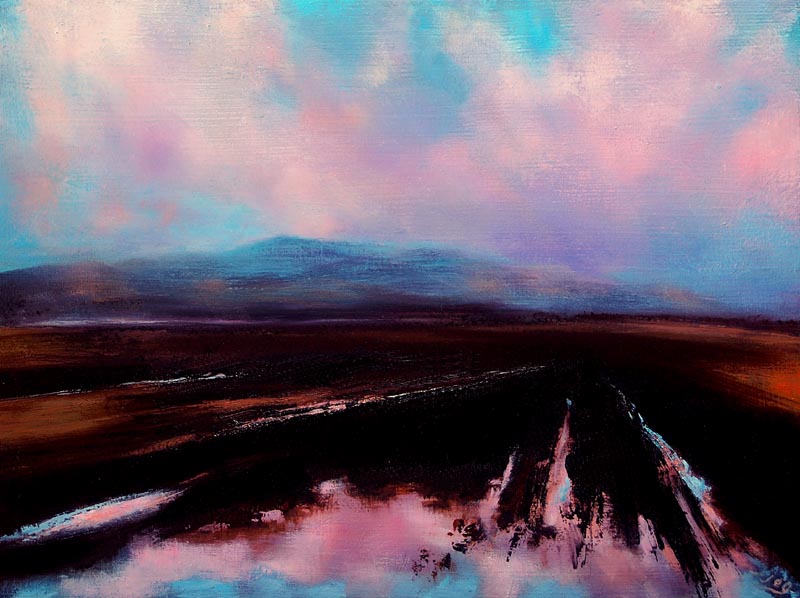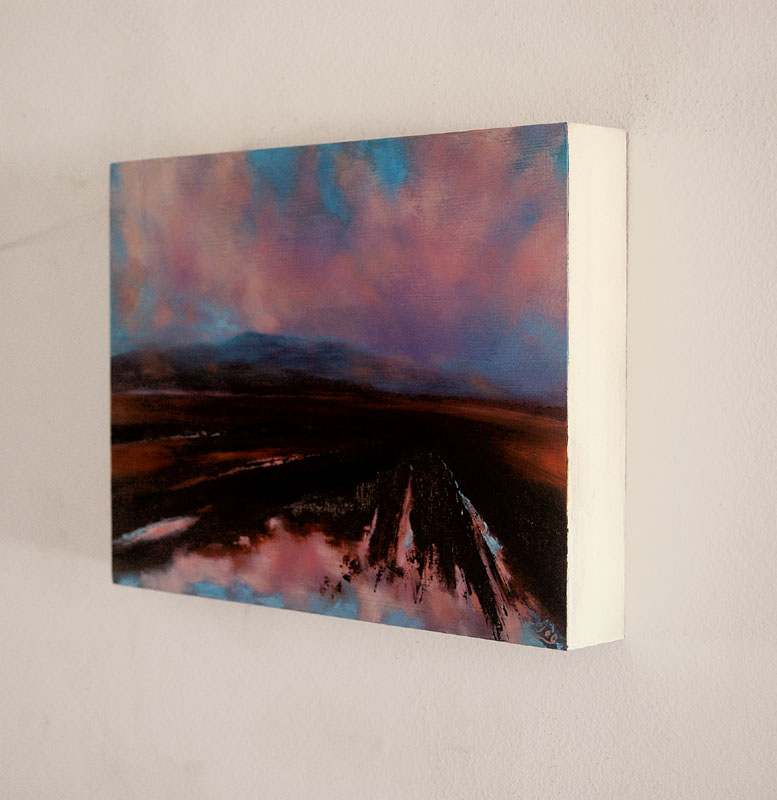After the Rain, Croghan Hill, ©John O’Grady 2014
Oil on deep edged Beech Panel, 18 cm x 24.2 cm x 3.7cm deep
(approx. 7″ x 9.5″, no need to frame and ready to hang)
SOLD
The main artery that connects the cities of Dublin and Galway is the M6. It cuts the country in half and travels coast to coast.
The counties and towns that lie in between are often seen as places to pass through and are sometimes neglected by visitors and natives alike.
I was on this motorway a good few times and never noticed a hill on the left which rises out of the Midlands’ flatlands after you pass Kinnegad. This is Croghan Hill which is set in the middle of the Bog of Allen.
My interest was renewed about Crohan Hill after hearing recently of a newly discovered bog body.
My mind traveled back to when I first saw the remains of Old Croghan Man’s mummified body at the National Museum of Ireland’s display, “Kingship and Sacrifice”.
I felt stunned.
He looked so vulnerable and real, I felt as if I could touch his hand. It had the substance of a hand with flesh and bones.
Ireland has a strong, deep connection with the past and past human life that can resurface when you don’t always expect it as it’s always latent.
A few bog bodies have been discovered in the Midlands and I wonder how many more are lying there since possibly 4th century BC, in a fantastic state of preservation thanks to the cold, acidic, oxygen-free conditions that persist beneath peat bogs and prevent decay while mummifying human flesh.
Old Croghan Man was found at the foot of the hill. The hill itself was a landmark and local tribal kings were crowned there like on the Hill of Tara. And both afford a fantastic and strategic view of the surrounding countryside.
When looking up Croghan Hill on google maps, (isn’t google maps incredible?), I discovered that I had visited a friend nearby many years ago and seen this hill but didn’t realise it.
This painting is about my response to first seeing “Old Croghan Man” and the recollection of that visit to the hill.
I would love to hear what you think of my painting and if you have seen the bog bodies?


Perfect!! We were so moved by all of the “bog bodies” at the Museum and the very tasteful way in which they were revealed. Another fine painting, rich with the depth of Irish history. Wonderful, John.
Hello Terry,
I have to agree, the respectful way in which they were displayed was very fitting and enhanced the experience of the sad end they met. Thank you Terry
Yes Pete bog!! nice story John..
Thanks Elles, a bog with lots of history too 🙂
Thanks for sharing your memories and reflections John – it is all so fascinating and adds depth and background when viewing the work. As you may remember we are fortunate enough to have an earlier ‘After the Rain’ painting which depicts a rush of water down the boggy, heathery hillside. In this one the angle is very different and there is a greater sense of depth and distance; instead of rushing water, the focus is on still, lying water with flushes of pink mirrored from the clouds above. In each though there is that sense of saturated wetness. It is indeed perfect!
Yes Christine, the first ‘After the Rain’ was a different more energetic painting I think. This one is more specific in terms of description of location but with the same overall feeling of wetness. Also your painting was in my mind very much set in the bogland of the hills. This second one is a flat landscape that has been almost industrialised through turf production, only Croghan Hill emerges from the flatlands unscarred. Thank you for your comment.
When we travelled to Denmark, some years ago, John, we saw Tholland Man, the bog body that Seamus Heaney wrote about in a poem. Such a tender scene in the museum, to see him lying on his side as if he was sleeping for a thousand years. Your new painting is really dramatic and conjures up the scenes of ritual and drama. I really like it.
Hello Eoin,
That must have been really special, I have seen photos of Tholland Man, as you say it looks like he is sleeping. Thanks for the comment on the painting. I find it amazing how we can be transported back over two thousand years so easily, we tread so close to the past and the lives of others